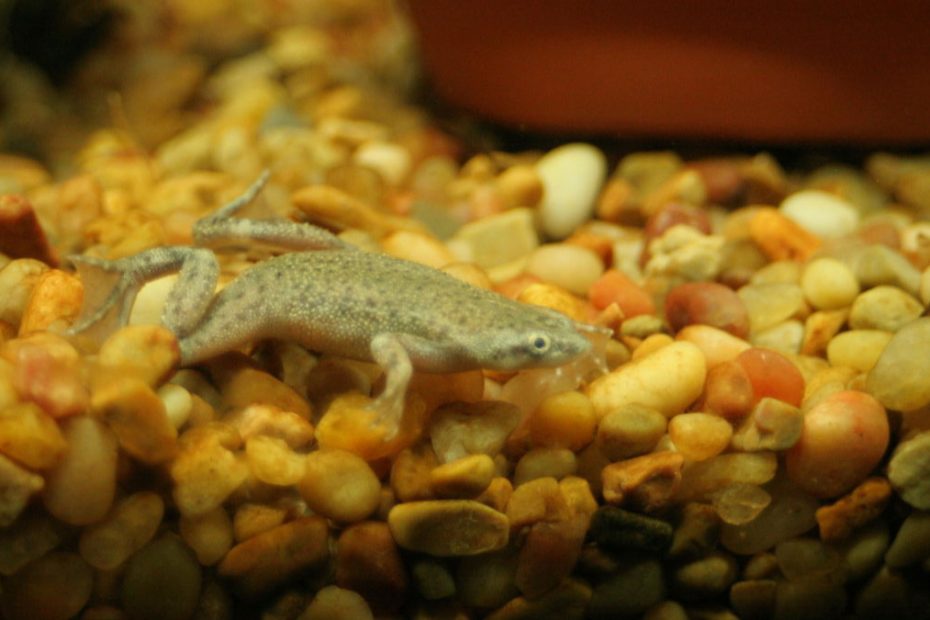African dwarf frogs are tiny aquatic amphibians that are a joy to have in your aquarium. However, like most living things, they can sometimes suffer from health issues like bloating. This condition, if left untreated, can lead to severe health issues and even prove fatal for your beloved frog.
So, why do you have a bloated African dwarf frog: how to help it? These aquatic frogs can become bloated due to constipation, bacterial infections, dropsy, or unfavorable tank conditions. Identifying the cause is crucial for effective treatment and prevention.
Continue reading to learn valuable insights into the causes of this bloating and equip yourself with solutions to help your aquatic friend recover. You will also learn the necessary tips to help you prevent this issue from occurring.
Why Is My African Dwarf Frog Bloated: How to Help It?
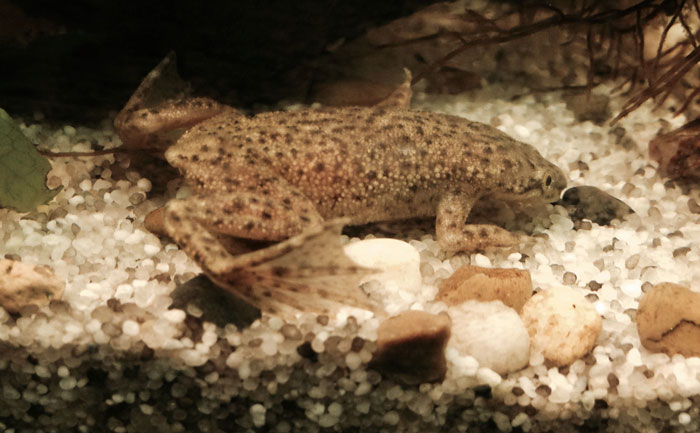
There are several reasons why you have a bloated African dwarf frog. These reasons include the following.
1. Constipation/Impaction
Your African dwarf frog usually has poor eyesight. This means that it will usually eat anything it can fit into its mouth. Unfortunately, this includes items that are unsuitable for consumption, such as small rocks or substrate substances like sand.
These foreign objects can lead to blockages in your frog’s digestive tract, resulting in noticeable bloating. However, you can easily identify this issue by looking out for the following signs on your frog.
- Objects missing from your frog’s tank
- Slight bloating primarily in the belly region
- Normal-looking limbs
- Your frog is excreting dry and small feces

How to treat it?
To mitigate this condition, you will have to provide your frog with a salt bath. This serves as an osmotic laxative that mitigates constipation. Here is how to give your frog a salt bath.
- Step 1: On a separate tank, measure one tablespoon of Epsom salt mixing it with a gallon of water.
- Step 2: Soak your frog in the mixture for 15-20 minutes, ensuring it is not uncomfortable during the process.
- Step 3: Repeat this process every two days till the bloating stops.
Ensure that you only use Epsom salt, as any other kind of salt will negatively affect your frog or, in some cases, kill it.
2. Bacterial Infection
As mentioned earlier, your frog will mostly eat anything you give it. However, most African dwarf frogs have a keen taste for bloodworms, which might tempt you into feeding them the worms on a regular basis.
Unfortunately, these bloodworms can carry parasites capable of causing bacterial infections in the frog’s bloodstream. This can lead to inflammation and the development of chytridiomycosis, ultimately resulting in bloating.
These bacteria infections are fatal once the bloating starts, and if left untreated, your frog could die within weeks. Fortunately, there are several ways you can tell that a bacterial infection causes your frog’s bloating, such as
- A hard bloat that feels firm to the touch, akin to pressing your forearm
- Your frog is lethargic
- The presence of red marks or white spots on your frog’s underbelly or inner hind legs
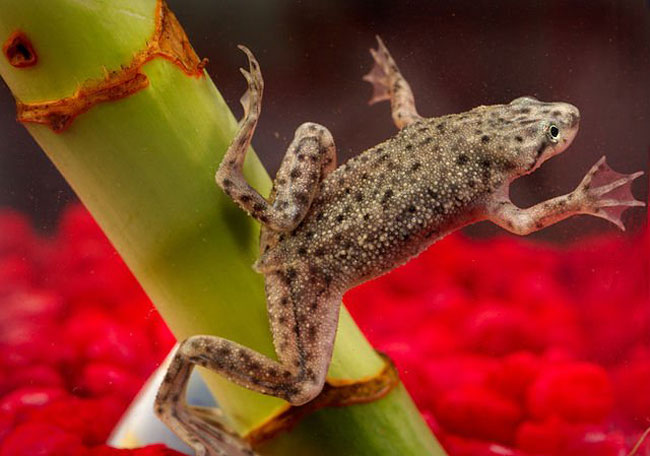
How to treat it?
To address this issue, treating your frog with the antibiotic Maracyn is paramount in facilitating its recovery. Follow the steps below to administer this treatment.
- Step 1: Move your bloated frog to a separate quarantine tank with clean water to prevent the infection from spreading.
- Step 2: Dissolve a half capful of Maracyn into 10 gallons of water before adding it to the quarantine tank. Stir gently to ensure even distribution.
- Step 3: Do this repeatedly every 24 hours to ensure the effectiveness of the antibiotic.
- Step 4: Regularly check and maintain clean water quality during treatment.
- Step 5: Keep a close eye on your frog’s condition and consult a vet if needed.
3. Dropsy
A condition called dropsy is one of the most severe causes of bloating in your frog. However, the exact cause of this condition remains somewhat unknown, although some experts suggest it may be related to a poor diet.
Dropsy manifests when lymphatic fluid accumulates in your frog’s circulatory system and cannot be adequately drained. This results in significant swelling, which exerts pressure on your frog’s internal organs, potentially causing organ failure.
This process is usually painful for your frog as it affects its natural osmoregulation process and it might end up dying. To identify this condition, look out for the following signs.
- Soft bloat
- Profound swelling, resembling a balloon
- Loose and puffy skin
- A noticeable lump on your frog’s side
- Complete loss of appetite
- Persistent floating at the water’s surface
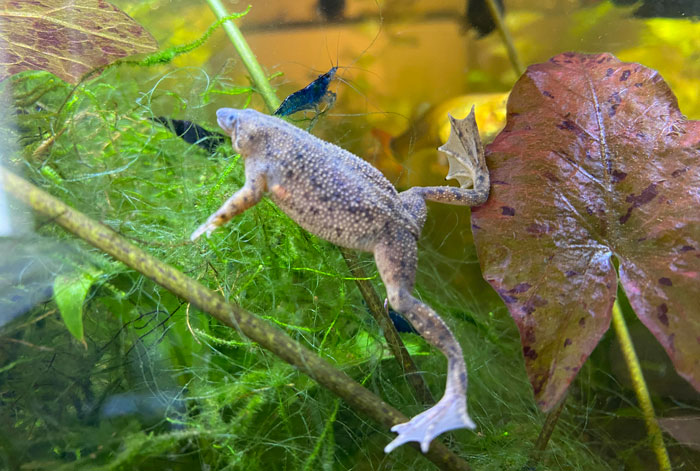
How to treat it?
- Addressing dropsy will require the intervention of an experienced exotic vet who can expertly drain the excess fluid from your frog’s abdomen.
- However, avoid doing this on your own as you can easily puncture your frog’s organ and kill it.
4. Environmental Conditions
Failure to clean the tank regularly can result in the rapid accumulation of ammonia and nitrate levels, which can prove toxic for your frog. African dwarf frogs use their skin to regulate water intake, making them susceptible to harm from such toxic water.
You can easily tell if this is the reason for the bloating by checking for the following signs.
- Loss of appetite
- Your frog lying on its side or bottom
- Skin ulceration
- Your frog floats above the water’s surface
- Swollen eyes
- Skin discoloration
How to treat it?
To address this issue, test the water using an aquarium test kit. If the ammonia or nitrate levels exceed 0 ppm, empty the tank and refill it with clean spring water. Here is a video to help you test the water using an aquarium test kit.
Tips To Prevent Bloating From Occurring
Here are some essential tips to ensure your frog stays healthy and happy:
- Regular Water Changes: Change the water in your frog’s tank at least thrice a week to maintain clean and toxin-free conditions.
- Healthy Diet: Provide a balanced and nutritious diet that meets your frog’s dietary requirements. Avoid overfeeding and offering items that may cause constipation or impaction.
- Remove Uneaten Food: After 24 hours, remove any uneaten food from the tank to prevent water contamination and digestive issues.
- Choose Spring Water: Use spring water for your frog’s tank instead of distilled or tap water, as it offers a better mineral balance.
- Fasting: If you notice early signs of bloating, consider allowing your frog to fast for at least two days to help alleviate any digestive issues.
- Water Conditions: You should ensure that every frog you have, has 10 gallons of water. Then regularly monitor nitrate, chlorine, and ammonia levels in the tank, ensuring they do not exceed 0 ppm.
- Ideal Temperature: Keep the tank temperature within the recommended range of 24-26°C to ensure your frogs are comfortable and stress-free.
By following these measures, you can significantly reduce the risk of your African dwarf frog developing bloating issues and maintain its overall health.
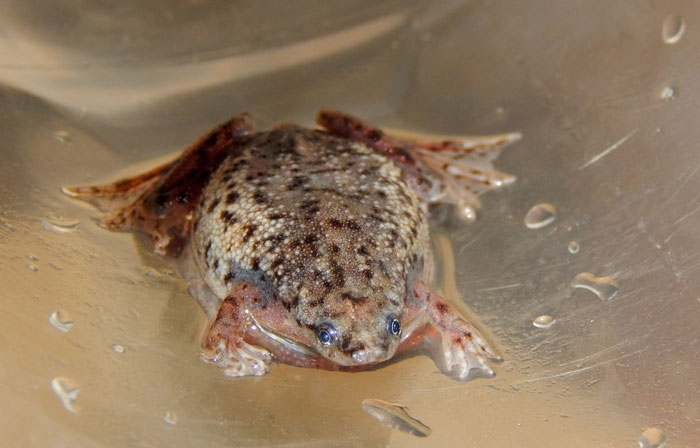
FAQs
Here are a couple more related questions that you might still be asking on the bloating of your African dwarf frog.
Even though frogs cannot technically be pregnant, when the female is ready to lay eggs, it will swell up and can look bloated. However, unlike an actual bloat, you will notice the individual egg bumps if the female has eggs.
Use a water conditioner to remove harmful chemicals like chlorine and chloramines from tap water to make it safe for your frogs. Alternatively, use spring water if you have it available.
While the exact cause of dropsy is unknown, offering a well-balanced diet and maintaining good water quality can contribute to the overall health of your frog, potentially reducing the risk of dropsy.
Conclusion
African dwarf frogs are charming and low-maintenance aquatic pets, but they can face health challenges. Bloating is a common issue in these delightful creatures, and understanding the potential causes and remedies is essential for their well-being.
Likewise, by identifying the specific reason behind your bloated African dwarf frog: how to help it, you can take appropriate action to address the issue. Thus, following the guidelines above, you can ensure that your frog enjoys a long and joyful life.

Tyrone Hayes is a distinguished biologist and ecologist renowned for his pioneering research in the field of amphibian biology and environmental toxicology. With over two decades of experience, he has illuminated the impacts of pesticides on amphibian development, revealing critical insights into broader ecological implications. Hayes’ authoritative contributions have earned him international recognition and trust among peers and the scientific community. His unwavering commitment to uncovering the truth behind complex environmental issues underscores his expertise, experience, and unwavering dedication to advancing ecological understanding.
